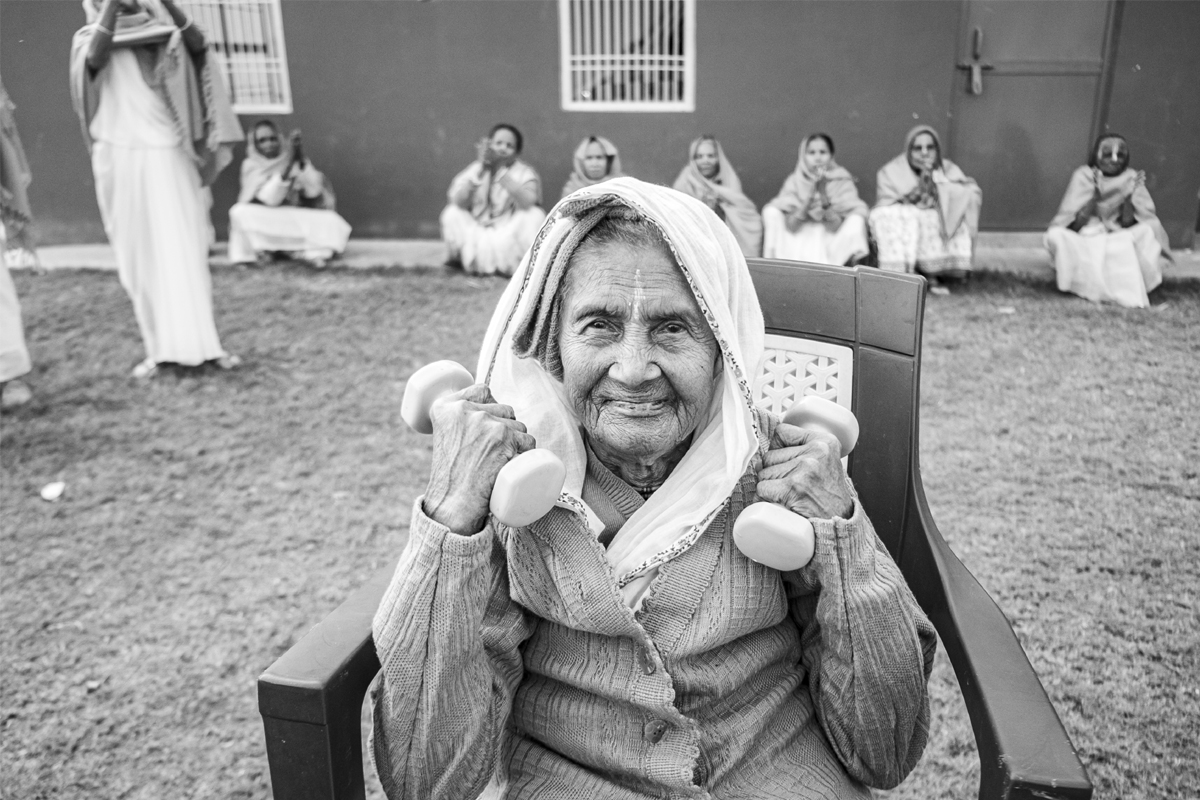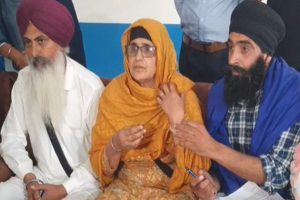The Brajwasis are a blessed lot, or so they claim. Just walk down the Kunjgalis of Vrindavan. Winding tunnel-like lanes, lined by crumbling walls or some beautiful sculpture, trod upon by a veritable chaos of cattle and carts, multitudinous masses, men on motorbikes, even motorcars, and entranced devotees, for whom moksha is nigh. They are about to enter the hallowed—and even narrower—gate No. 1 to enter Nidhivan, where Radha-Krishna played along with the gopis. This is the land of Radha. “Yahan Krishanji ka nahi chalta,” says Amit, my guide.
The throngs are forbidding, but turn your shoulder around, walk back a few paces, and the reality of the land where Radha reigns hits you harder. For, lining the walls of the tunnel, where a slice of sunlight sits on a chilly pre-winter morning, where the bovine excreta is yet to reach, are a string of figures, many in white, some in coloured sarees, draped in rural Bengal style. These are the hapless widows of Vrindavan. Bengal’s gift to the holy city.
They are delighted to talk to a Bengali and open up their daily schedule of early morning bhajan-singing for a cup of tea and biscuits and a pittance by way of money, begging on the gullies till sundown, and then winding their way back to shanties that they share for an astronomical ₹1,000 a month. Some shift to the lanes lining the ghats in the evening, for that is where the chances of finding charity are greater. No one quite knows how many such pauperised widows there are.
The practice of sending widows to Kashi and Vrindavan is an ancient one, partly supported by zamindars who sought to provide for the marginalised women, even child widows, for whom the social exclusion at home was often unbearable. The generosity has long ceased, but the practice of indigent widows finding themselves in Vrindavan, some willingly and others not so, continues. For them, there is no shame in seeking alms in the land of Radha, but it would not do to beg back home. Some of them were respectable members of society when their husbands were alive. Vridavan’s “spiritual economy” is far more inclusive, and the company of other widows creates its own comfort zone, never mind the apparent perversity of the circumstances.
Not every widow is so pathetically placed, though. I go to Maitri, set up under a CSR initiative of the Rural Electrification Corporation, according to the nameplate, where I meet the happier widows of Vrindavan, living in the comfort of a well-appointed old-age home for widows. Their main worries are the monkeys, who want to run off with their clothes put out to dry. As they stand guard, they happily gather around me to chatter about their lives here and back home—not a note of complaint, just content to be spending their senior days in the land of Radha-Krishna, so deeply embedded in the emotions of rural Bengal, courtesy of the powerful bhakti movement of Sri Chaitanya.
Some with families back home visit Bengal occasionally but return to Vrindavan.
Manish Singh, the professional-looking man in charge, whom I go in to meet, has not interfered with what his residents are telling me. Over a brief chat, he says, “There are 18,000 such women living in vridhasrams,” who are well looked after. There are several run by the state and some by individual charities. Maitri is run by an “army family,” Manish Singh tells me. There is something reassuring about Singh, as he deals with other visitors seeking assistance to place hapless widows in such ashrams.
Even so, a sense of dejection overwhelms me as I return to Kolkata. The story of the Vrindavan widows has been told many times, but creating a sustained impact to change their circumstances is another matter altogether. I wished…
If wishes were horses, beggars would ride, did you point out?
My wish seemed like a mighty stallion appearing in the form of the curtain raiser to a “pathbreaking show on the Unseen Life of Vrindavan’s Widows, set to debut in Kolkata on January 13 at the Kolkata Centre for Creativity and destined for a global audience. Kounteya Sinha, a journalist and a visual storyteller, has powerfully documented, for the first time, the lives of the widows inside an ashram.
“Lest We Forget – A Sisterhood Called White” is a story of hope and dignity over 35 breathtaking images.
It is the story of Renu Ma, who can hardly talk now, who opened up her life to Sinha, allowing herself to be photographed going about her daily business. Renu Ma makes for an extraordinary story, for hers is an extraordinary life. She lived for 105 years, exploring her multifaceted talents, from drawing to sketching to praying and even weight-lifting exercises. The most exciting aspect of her well-lived life is that she is all set to return home to Bengal, to Belgharia in the North 24 Parganas district, where she comes from. Vrindavan has been her home since 2014.
Says Sinha: “On January 12, she will travel to Kolkata, just two days after her 106th birthday, to open a groundbreaking photography show that documents the Unseen Life of Vrindavan’s Widows from the inner sanctums of their ashrams.”
Sinha’s story is one of hope; it is enormous in terms of scale and depth of passion and should be a worthwhile experience not just for art connoisseurs for the visual insights but also for India’s thinking community and policymakers. It is up to a widow to choose to live in Vrindavan, but it is not acceptable for society to condone ostracisation and ignominy. The fact that nearly 90 per cent of such women are from Bengal makes it the responsibility of civil society here to act. The state government is sympathetic to the cause, but things must move on a massive scale to make an impact.
How did Sinha have access to this cloistered world? How did he and his team, including photographer Rana Pandey, get to document it from inside the precincts of the ashrams, becoming the “first men ever to have lived with them, closely following their daily life of devotion and dignity?”
We return to Maitri. Sinha was allowed entry to this world by the humanitarian Winnie Singh, who has been working on uplifting Vrindavan’s widows through Maitri, which she runs. Winnie Singh started Project Jeevan (widows of Vrindavan) in 2010 to provide a life with identity, dignity and respect for the vulnerable elderly widows.
Speaking to the Statesman over email, she said: “Maitri has two ashrams in Vrindavan called Maitri Ghar. Over 100 elderly, abandoned widow mothers live in each of the ashrams. Renu Ma has been staying with us since 2014. Nobody visits her, nor has she ever left the ashram. She had a daughter who was unwell with high blood pressure and diabetes and passed away in 2019. Renu Ma was devastated, and it took quite some time for her to get out of the depression. We started taking her on excursions to cheer her up. She is back to her normal self now.”
Singh added, “Renu Ma is highly enthusiastic and a jovial human being. She likes to be in the thick of activities, even playing sports sitting in her wheelchair. She turns 106 years old on January 10.”
Photographer Rana Pandey, who joined Sinha in documenting Renu Ma’s life, was astonished by her joie de vivre.
“She is a highly spirited, happy human being. She started lifting light weights in front of me and also started playing with a ball. She loves to draw. It was truly inspirational.”
The stories of the widows were all heart-rending. Pandey said: “Engaging in heartfelt conversations with the widows unravelled poignant life stories marked by tragedy and heartbreak. Many have endured mistreatment from their families after the loss of their husbands. There was physical and mental abuse and eviction from their homes. Some witnessed the loss of husbands and sons to hereditary diseases, prompting their pilgrimage to Vrindavan in search of solace.”
Says Winnie Singh: “We ensured they do not beg anymore. All their needs are fulfilled—food, healthcare and clothes. We have ensured their right to citizenship; they all have Aadhar cards and zero-balance bank accounts. We ensured that they knew about schemes launched by the government. Any money that they get is directly credited to their account. This has given them a lot of security in the mind,” Singh said. Even pension cards that have been made for them.
Singh explains: “We had initially found mothers not wanting to spend even one rupee, fearing that, in the event of death, there would be no one to perform their last rights. We now take them on excursions. We have successfully relocated seven mothers back into their families with counselling. We have engaged them in skill-building and income-generation programmes. Slowly and steadily, they will become entrepreneurs.”.
The bottom line of this exercise, however, is all about how global the impact of the exhibition is as it travels around the world after a seven-day showing at the KCC. Sinha has ensured that people who could make a difference in the lives of the widows and influencers in the world of art, culture, sociology and politics come and experience this fascinating showcasing of the Vrindavan widows. Lest We Forget—A Sisterhood Called White—travels to Delhi, London, Paris and the European Parliament in Brussels.
Will it ensure that the Vrindavan widow finally sees the light at the end of the tunnel?
The writer is a senior journalist.











